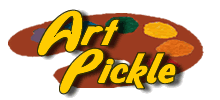| The Language of Art |
| by Our Art Studios |
|
There is an oft spoken phrase regarding the act of looking at an image. The viewer may choose to see the image in the minds eye or in the eyes mind. Huh? What does that mean? Sometimes just repeating the phrase is confusing. Consider a still life. A vase of fresh flowers backlit from sunlight sits on the window sill. Viewed from the minds eye, we know we are looking at flowers, so we can just draw a flower, petals, stem, vase with some bright colored water, some yellow sunlight in the background because that is what it is. But what if you had no idea of what a flower or a vase was? Window sill, what's that? Can you imagine? Maybe you have looked at an abstract painting once at a museum and felt that it made no sense to you, it was merely made up of some pattern of colored forms. If you were asked to duplicate the abstract painting you would probably pay close attention to the forms and their relationship, their values and colors as you recreated the picture. It probably wouldn't matter if the painting was flipped upside down or sideways. This is because you are seeing with the eyes mind. Forms, not objects. Seeing the flowers and the vase with the eyes mind is to see it without a preconceived idea of what it is. Seeing the forms and their relationship to each other. It is not an easy task to see with the eyes mind. Our expectations influence our perceptions. Are you looking or are you actually seeing? Are you hearing or are you truly listening? Can we pause long enough to slow down and turn off our history for a moment… to dissolve all our prejudices before opening our eyes. Enter a scene as a new world. Try squinting and imagine that everything you are looking at has no meaning…it is simply forms and shapes of light and dark and bursts of color and geometric patterns. Maybe it is a feeling, a warmth, a melancholy, a measure of time, time moving fast, time suspended, time dancing all at once. Is there movement. Maybe the patterns are organic, maybe structural. Is there balance, or asymmetry? In the book Art and Illusion by E. H. Gombrich, the author considers that the interpretation of art becomes as much the responsibility of the spectator as that of the artist. It is the viewers call, it is their subjective observation and prejudices that render a particular truth, recognition or emotional response to what they see before them. So many viewers, so many opinions. A flower in a vase, or the fleeting last light from a warm afternoon, or a shower of light, or remembrance of a lost love. The viewer shares the responsibility of seeing in, of accepting or rejecting, or rearranging the illusion before them, attaching their own truths and ideologies. Between the artist and the spectator lies a panoply of viewpoints and a twilight of truths.
|
| 2007 - 2024 All Rights Reserved | |||||||||
|
Website designed and hosted by SonomasStudios |
|||||||||


